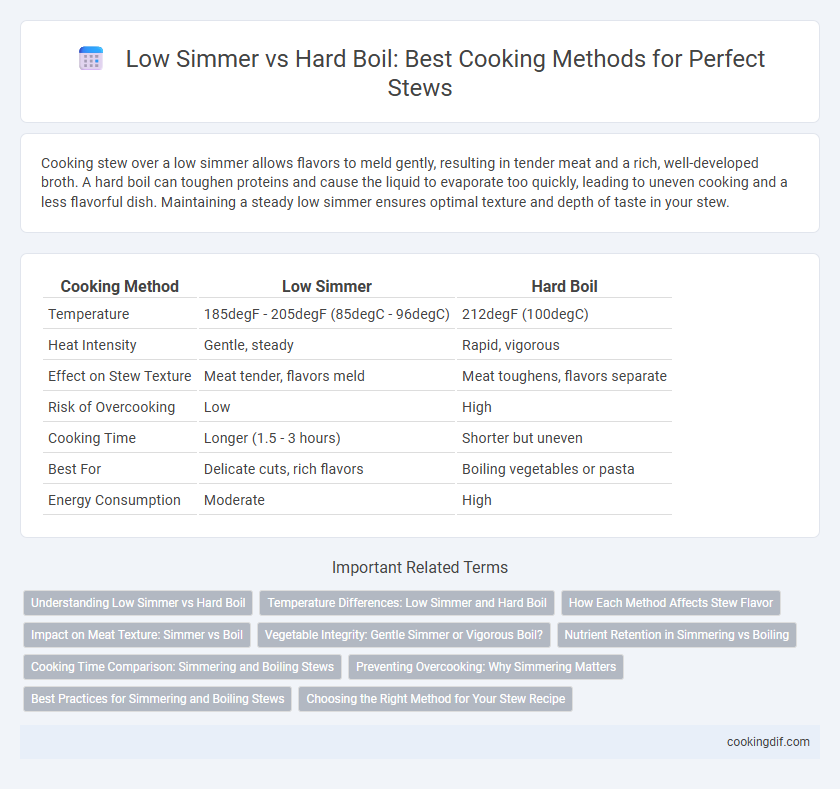Cooking stew over a low simmer allows flavors to meld gently, resulting in tender meat and a rich, well-developed broth. A hard boil can toughen proteins and cause the liquid to evaporate too quickly, leading to uneven cooking and a less flavorful dish. Maintaining a steady low simmer ensures optimal texture and depth of taste in your stew.
Table of Comparison
| Cooking Method | Low Simmer | Hard Boil |
|---|---|---|
| Temperature | 185degF - 205degF (85degC - 96degC) | 212degF (100degC) |
| Heat Intensity | Gentle, steady | Rapid, vigorous |
| Effect on Stew Texture | Meat tender, flavors meld | Meat toughens, flavors separate |
| Risk of Overcooking | Low | High |
| Cooking Time | Longer (1.5 - 3 hours) | Shorter but uneven |
| Best For | Delicate cuts, rich flavors | Boiling vegetables or pasta |
| Energy Consumption | Moderate | High |
Understanding Low Simmer vs Hard Boil
Low simmer involves gently cooking stew at temperatures just below boiling, around 185-205degF (85-96degC), which allows flavors to meld and meats to tenderize slowly without breaking down. Hard boiling, at 212degF (100degC), can cause tough cuts of meat to become firm and grainy while reducing the stew's overall clarity and flavor depth. Maintaining a low simmer ensures optimal texture and richness by preserving moisture and enabling slow collagen breakdown essential for a hearty, well-balanced stew.
Temperature Differences: Low Simmer and Hard Boil
Low simmer cooking maintains a temperature between 185degF to 205degF, allowing flavors to meld slowly with gentle bubbling that prevents toughening of ingredients. Hard boiling occurs at a full 212degF, creating vigorous bubbles that can break down delicate proteins and cause food to become stringy or dry. Understanding these temperature differences ensures optimal texture and flavor development in stews.
How Each Method Affects Stew Flavor
Low simmering allows stew ingredients to slowly release flavors and tenderize meats, enhancing depth and complexity in the broth over time. Hard boiling causes rapid agitation and high heat, which can break down ingredients unevenly, often resulting in a thinner, less developed flavor profile. Maintaining a steady low simmer preserves the stew's richness and blends spices and herbs more effectively than the harsh intensity of a hard boil.
Impact on Meat Texture: Simmer vs Boil
Low simmering maintains a gentle heat that slowly breaks down collagen in meat, resulting in tender, succulent texture ideal for stews. Hard boiling, by contrast, agitates proteins aggressively, causing them to contract and toughen, which can lead to dry and chewy meat. Simmering preserves moisture and flavor, producing a rich, melt-in-your-mouth consistency preferred in slow-cooked dishes.
Vegetable Integrity: Gentle Simmer or Vigorous Boil?
Cooking vegetables in a stew at a low simmer preserves their shape, texture, and nutritional integrity by preventing excessive breakdown of cell walls, which can occur during a hard boil. Vigorous boiling leads to rapid water movement that causes vegetables to become mushy and lose valuable vitamins like vitamin C and B-complex. Maintaining a gentle simmer allows flavors to meld gradually while keeping vegetables firm and visually appealing in the final dish.
Nutrient Retention in Simmering vs Boiling
Simmering at a low temperature helps retain more nutrients compared to a hard boil, which can cause nutrient degradation due to intense heat and agitation. Stewing ingredients gently in a low simmer preserves vitamins like vitamin C and B-complex that are sensitive to high heat. This cooking method enhances flavor development while maintaining the nutritional quality of the stew.
Cooking Time Comparison: Simmering and Boiling Stews
Simmering stews at a low simmer typically requires 1.5 to 3 hours to fully develop flavors and tenderize meat, whereas hard boiling drastically reduces cooking time to around 30 to 45 minutes but can toughen proteins and dilute flavors. Low simmering maintains a steady 185-205degF temperature that gently breaks down collagen and fats, enhancing texture and taste. Rapid boiling at 212degF causes more vigorous agitation that can break down ingredients unevenly and cause stews to lose their rich, concentrated essence.
Preventing Overcooking: Why Simmering Matters
Simmering stew at a low temperature between 185degF and 205degF prevents overcooking by allowing flavors to meld gently without breaking down delicate ingredients. Hard boiling causes intense agitation and rapid evaporation, leading to tougher meat and diminished texture. Maintaining a low simmer ensures tender, flavorful results by preserving moisture and controlling the cooking process carefully.
Best Practices for Simmering and Boiling Stews
Maintaining a low simmer is essential for cooking stews to achieve tender, flavorful results by gently breaking down tough meat fibers and blending ingredients without overcooking. Hard boiling causes rapid evaporation and toughens proteins, resulting in less tender meat and diluted flavors. Best practices for stewing involve keeping the temperature between 180degF and 205degF, ensuring small, gentle bubbles form and occasionally stirring to prevent sticking.
Choosing the Right Method for Your Stew Recipe
Choosing between low simmer and hard boil for your stew depends on ingredient texture and flavor development. Low simmer gently breaks down tough meats and melds flavors over time, enhancing tenderness without toughening proteins, while a hard boil can toughen meats and cause cloudy broth. For a rich, tender stew, maintain a consistent low simmer to achieve optimal taste and texture.
Low Simmer vs Hard Boil for Cooking Method Infographic

 cookingdif.com
cookingdif.com